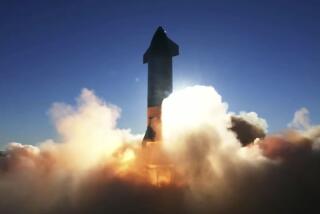A New Door, Some Rewiring, and Off We Go : Space: The U.S. should buy Russia’s Mir orbiting station.
- Share via
The last Soviet cosmonaut has returned to Earth. As Sergei Krikalev closed the air lock of the space station Mir (Peace) this week, leaving behind his Russian successors, he brought to an end a Cold War contest that began with Sputnik in 1957. Thus in simple actions does the world--and its satellites--move on.
Unfortunately, all transitions are not so smooth. On Earth, the people who built Mir, more concerned about food than the future, are turning their backs on space. The United States faces the difficult question of how best to help. As many have pointed out, trade, not aid, is the answer.
We should offer to buy or lease the Mir space station, or parts of it, right now.
Think about it. By the end of this year, we could have a permanent American presence in space. And sending an American to Mir would also fulfill President Reagan’s about-to-be-broken promise of a U.S. space station by 1992.
Using Mir, we could start now to develop and test the technologies we will need aboard NASA’s space station Freedom. Then, when Freedom comes on line about the year 2000, we will have had seven years of on-orbit time and possess two space stations. Two space facilities of very different types, with room for all of our international partners (both old and new).
Of course, there are hurdles to be overcome. For example, some of Mir’s docking systems need to be reinforced. And, although obviously functioning, the systems on board Mir are primitive, and would have to be rewired to meet our higher standards.
Part of the solution to this is sitting on the ground in Russia, in the form of two large, new expansion modules for Mir, ready to launch. These could be packed with high-tech computer, life support and communications systems made in America by our aerospace companies and launched by Russian technicians on our payroll.
The entire rationale of our space-station program is to learn how to live and work in space. Surely a little shirt-sleeve interior rewiring can’t be that daunting to the same agency that now proposes tens of thousands of hours of spacesuit time outside Freedom, simply to keep it going?
Unfortunately, there is an iron triangle that will do almost anything to stop this idea.
First are the NASA managers, who will create a thousand very credible-sounding reasons for not doing anything this bold. All of the excuses will boil down to, “We don’t want to.” The NASA centers can’t even accept each other, so why should we expect them to want to use a piece of hardware from a different country? Second are those who don’t want Vice President Dan Quayle (who presides over space for the White House) to score any victories. Last (but not least) are the foaming-at-the-mouth anti-communists who believe that the “evil empire” might rise again and are determined to prevent it, at any cost.
This great idea will probably be talked to death, then abandoned. It is sad and symptomatic that the nation that says it wants to lead the world into the new frontier of space can’t grasp the same sorts of opportunities with which it created itself. About 125 years ago, the Russians sold us another piece of frontier property. Called “Seward’s Folly” at the time, it was denigrated by the same types who will laugh at this proposal.
Alaska, however, has turned out to be a pretty good investment.
More to Read
Sign up for Essential California
The most important California stories and recommendations in your inbox every morning.
You may occasionally receive promotional content from the Los Angeles Times.










